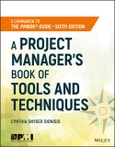A practical guide for putting PMBOK concepts to work
A Project Manager’s Book of Tools and Techniques is an invaluable resource for students and working professionals alike. Whether you’re preparing for the PMP exam or just looking to optimize your project management skills, this book provides detailed explanations for over 100 essential tools described in the Project Management Institute’s A Guide to the Project Management Body of Knowledge (PMBOK Guide) Sixth Edition. Going beyond theory and concept to real-world practice, these tools and techniques are the “how” of effective project management; from planning, to implementation, to oversight, and beyond, all phases of the project are represented here to help you more effectively apply critical PMBOK concepts. Comprehensive examples illustrate real-world implementation, and detailed discussion provides expert guidance for both new and experienced project management professionals.
Knowing what to do is much different from knowing how to do it; even perfect understanding of the PMBOK Guide doesn’t automatically translate into effective practice. This book is designed to help you bridge that gap and expertly apply current project management standards.
- Delve deeper into the practical tools described in the PMBOK Guide - Sixth Edition
- Follow detailed examples that illustrate effective project management methods
- Master project management applications in preparation for the PMP exam
- Graduate from theory to practice with powerful tools and techniques for success
Concepts are only valuable once they are applied - and then they become a skill set that gets results. The PMBOK Guide is the ultimate authority on project management concepts, but translating those concepts into applicable skills requires a detailed understanding of the tools of the field. A Project Manager’s Book of Tools and Techniques is a practical manual for putting essential project management concepts into practice.
Table of Contents
Acknowledgments vii
Introduction ix
Part 1 Data Gathering 1
1.0 Data Gathering Techniques 2
1.1 Benchmarking 3
1.2 Brainstorming 6
1.3 Check Sheets 8
1.4 Checklists 10
1.5 Focus Groups 12
1.6 Statistical Sampling 14
Part 2 Data Analysis 17
2.0 Data Analysis Techniques 18
2.1 Alternatives Analysis 19
2.2 Cost Benefi t Analysis 24
2.3 Cost of Quality 27
2.4 Decision Tree 31
2.5 Earned Value Analysis 36
2.6 Infl uence Diagrams 41
2.7 Make-or-Buy Analysis 44
2.8 Performance Index 46
2.9 Regression Analysis 48
2.10 Reserve Analysis 51
2.11 Root Cause Analysis 55
2.12 Sensitivity Analysis 58
2.13 Stakeholder Analysis 63
2.14 SWOT Analysis 67
2.15 Technical Performance Analysis 70
2.16 Variance Analysis 72
2.17 What-If Analysis 74
Part 3 Data Representation 77
3.0 Data Representation Techniques 78
3.1 Cause-and-Effect Diagram 79
3.2 Control Charts 82
3.3 Flowcharts 87
3.4 Histograms 90
3.5 Logical Data Model 93
3.6 Mind Mapping 96
3.7 Probability and Impact Matrix 98
3.8 Resource Breakdown Structure 101
3.9 Responsibility Assignment Matrix 103
3.10 Scatter Diagrams 106
3.11 Stakeholder Mapping 108
Part 4 Estimating 111
4.0 Estimating Techniques 112
4.1 Analogous Estimating 113
4.2 Bottom-Up Estimating 116
4.3 Estimate at Completion 119
4.4 Estimate to Complete 123
4.5 Parametric Estimating 126
4.6 To-Complete Performance Index 128
4.7 Three-Point Estimating 131
4.8 Variance at Completion 134
Part 5 Interpersonal and Team Skills 137
5.0 Interpersonal and Team Skills 138
5.1 Confl ict Management 139
5.2 Decision Making 145
5.3 Nominal Group Technique 151
5.4 Problem Solving 153
Part 6 Other Techniques 157
6.0 Other Techniques 158
6.1 Context Diagram 159
6.2 Critical Path Method 161
6.3 Funding Limit Reconciliation 170
6.4 Inspection 172
6.5 Leads and Lags 174
6.6 Precedence Diagramming Method 177
6.7 Prompt Lists 181
6.8 Prototypes 184
6.9 Resource Optimization 186
6.10 Rolling-Wave Planning 189
6.11 Schedule Compression 192
Appendix: Case Study Scenarios 197
Index 203








